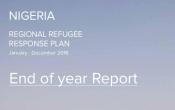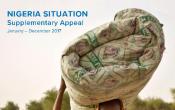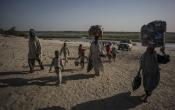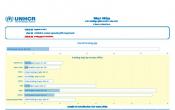Niger
Operation: Niger
Location
{"longitude":8,"latitude":18,"zoom_level":0}
Latest update of camps and office locations 21 Nov 2016. By clicking on the icons on the map, additional information is displayed.
Key Figures
| 2016 end-year results | |
| 23,000 | displaced families in the Diffa region received gas for energy |
| 20,000 | people have access to water through a solar energy center in Tahoua |
| 9,500 | households in Diffa received emergency shelters |
| 2,000 | households in Diffa received land parcels |
| 400 | Malian refugee families in Tillabery received houses |
| 2017 planning figures | |
| 200,000 | individuals in the Diffa region will be reached through a census and registration in order to provide assistance and protection as well as address the risk of statelessness |
| 10,000 | households, as part of an extension to Diffa and Mangaize camp, will use gas as an alternative energy source |
| 3,000 | social land plots will be distributed to vulnerable Nigerian and Malian refugees and host households as part of an urbanization project |
| 70 | small projects will be carried out, including for poultry, other livestock, milk processing, industry support and gardening, to improve the self-reliance of Malian and Nigerian refugees and internally displaced people (IDPs) |
Latest Updates and Related Links
January - December 2017
People of Concern
9%
Decrease in
2016
2016
| 2016 | 302,227 |
| 2015 | 332,164 |
| 2014 | 147,936 |

[["Refugees",166093],["Asylum-seekers",65],["IDPs",121391],["Others of concern",14678]]
Loading ...
Niger
< Back
2016
{"categories":[2012,2013,2014,2015,2016,2017],"budget":[null,56.45169034,44.15721094,49.767155435,51.18816609,72.47623247],"expenditure":[null,30.65597188,26.55522036,27.8804749,25.34641563,null]}
{"categories":[2012,2013,2014,2015,2016,2017],"p1":[null,56.45169034,44.15721094,46.858700085,46.54393827,62.99399146],"p2":[null,null,null,0.25436852,0.94422782,0.685411],"p3":[null,null,null,null,null,null],"p4":[null,null,null,2.65408683,3.7,8.79683001]}
{"categories":[2012,2013,2014,2015,2016,2017],"p1":[null,30.65597188,26.55522036,25.69854914,20.99749897,null],"p2":[null,null,null,0.25079906,0.72452801,null],"p3":[null,null,null,null,null,null],"p4":[null,null,null,1.9311267,3.62438865,null]}
Loading ...
CHOOSE A YEAR
- 2014
- 2015
- 2016
- 2017
Working environment
In 2016, terrorist threats and attacks along the borders with both Mali and Nigeria increased. An attack in Bosso in June 2016 forced 70,000 people to flee to 100 spontaneous sites along the Route nationale 1. The Multinational Joint Task Force (MNJTF) increased military actions, limiting UNHCR’s access to some areas, with high population mobility also hampering UNHCR’s ability to provide assistance.In 2016, over 300,000 people transited through Niger as part of mixed movement flows. Government measures, such as check points, against smugglers made travel routes more complicated. Identification of asylum-seekers remained a priority.
Population trends
- In 2016, over 60,000 Malian refugees were registered in Niger, the highest number ever. UNHCR does not currently advocate for organized returns due to instability in Mali. However, some 2,400 Malians undertook assisted voluntary returns in 2016.
- In Diffa, the Government recorded some 241,000 displaced people; including 105,000 Nigerian refugees, 121,000 internally displaced people (IDPs) and 15,000 returnees. Nigerian refugee figures increased by 36,000 as a result of improved access and government engagement in registration activities.
- Niger also hosts more than 430 refugees and 65 asylum-seekers of other nationalities.
Achievements and impact
- Efforts were made to enhance self-reliance, through the use of cash transfers and collaboration with NGO livelihoods partners, to ensure the durable integration of Malian refugees.
- A Memorandum of Understanding was developed between the Government, IOM and UNHCR for the identification and referral of asylum-seekers in mixed movement flows.
- Community-based protection mechanisms in Diffa were strengthened through assessing the needs of 105 focal points, 98 committees, and 15 monitors.
Unmet needs
- Identification and documentation of the population of concern in the Diffa region must be improved.
- Important needs in livelihoods and income-generating activities (IGAs) remain unmet.
- Growing demographic pressure on social infrastructure requires an increase in qualified staff, as well as more resources.
- Capacity-building for local authorities and security forces remains crucial to ensuring international protection, respect for rights, and physical security for displaced populations.
UNHCR and its partners operate in a challenging humanitarian environment in Niger, with poor infrastructure, chronic droughts, seasonal flooding, extreme heat, violent winds and recurring epidemics (e.g. cholera and meningitis). Niger is ranked last in UNDP’s 2014 Human Development Index. The refugee programme is being carried out in a context where the resilience of the local population and institutions remains low. There is constant food insecurity, chronic malnutrition and a lack of infrastructure and services in rural areas. Access to the populations of concern is costly and poses significant operational and security challenges.
Niger also continues to be affected by the security situation in the region, which remains fragile, with instability prevailing in the north-east of Nigeria. The dry climate and fragile environment affect livelihood interventions, and this will continue to hamper the refugee operation in 2016, particularly in the Diffa region.
Building resilience and maintaining peaceful coexistence between the host community and refugees will be a priority for UNHCR and partners. Holistic and inclusive approaches to provide assistance to the affected population through development-oriented and innovative interventions will continue to be implemented.
The Government maintains its open-door policy and continues to allow humanitarian access and protection to those seeking refuge on its territory. Government and host community support include the preservation of and access to asylum and international protection, access to land and basic services, including health and education, markets and livelihood opportunities. UNHCR will continue to work closely with the Government to support protection measures and facilitate access to public services and assistance available to both Malian and Nigerian refugees.





